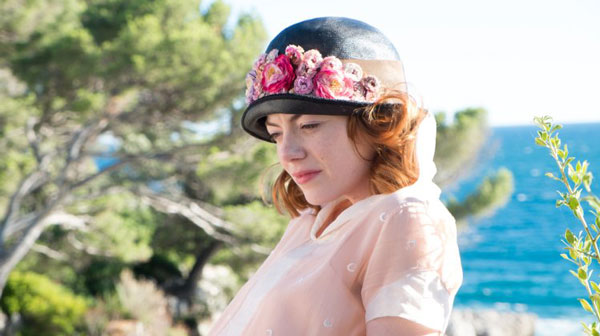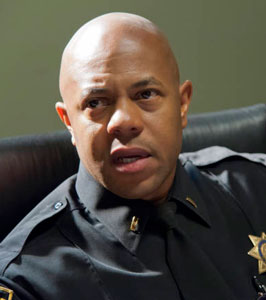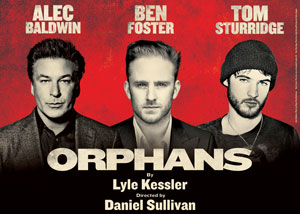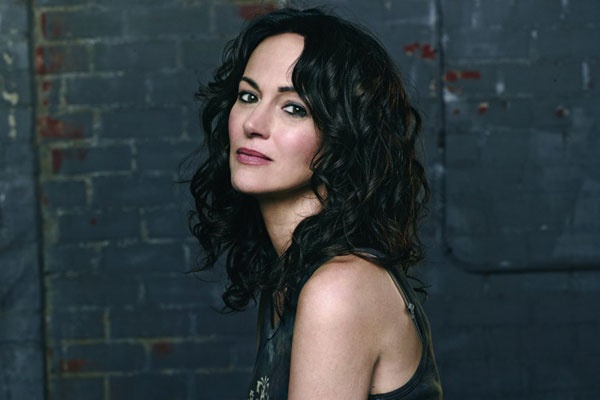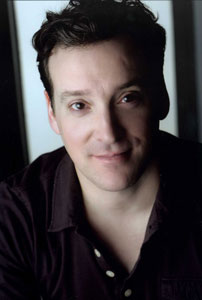 Jeremy Shamos, has been getting rave reviews for his performance in the new Broadway play, Clybourne Park. So good, in fact, that he was just nominated for a Tony Award for Best Performance by an Actor in a Featured Role in a Play.
Jeremy Shamos, has been getting rave reviews for his performance in the new Broadway play, Clybourne Park. So good, in fact, that he was just nominated for a Tony Award for Best Performance by an Actor in a Featured Role in a Play.
The show, written by Bruce Norris, was handed a total of 4 nominations (Best Play, Best Scenic Design of a Play, Best Direction of a Play and as previously mentioned Best Performance by an Actor in a Featured Role in a Play) and borrows some of the plot of Lorraine Hansberry’s Raisin in the Sun. The first Act takes place in 1959 Clybourne Park; a white couple has just sold their house to a black family as their nervous neighbors come over and try to convince the couple to stop the sale. ACT II begins 50 years later, with a young white couple about to buy that same house, raze it and start fresh. That idea is met with complete disapproval from the now African-American residents of the community.
Shamos, like each actor in the show, has dual roles. In ACT I, he plays Karl, the neighbor who disapproves of the sale of the house. In ACT II, he portrays Steve, part of the couple wanting to buy the original house. When I asked if either role was easier to get a handle on, he said that Norris’ writing was so specific that “both characters kind of came weirdly natural to me.”
Jeremy is a two-time Drama Desk nominee and Obie Award Winner whose prior Broadway credits include Elling, Reckless and The Rivals. After talking to Jeremy, I can honestly say that he’s an incredibly nice, funny and talented guy and I sincerely hope he wins the Tony Award.
In this interview, I talk to him about Clybourne Park and his dual roles, how he prepares for a part and his advice to actors.
Clybourne Park is currently play at the Walter Kerr theater. For tickets and more information, click here
You’ve been with this show from the very beginning, since 2010?
Jeremy Shamos: Yeah, all of us have. That’s the, kind of, extraordinary thing about it I think. We all have. It’s the same cast and it’s every single production element and everything is the same.
From preview night to opening night, were you guys still even then tweaking things?
Jeremy Shamos: We were. We were kind of polishing things up and also weirdly kind of un-polishing things and letting things, you know, find their place where they were when we were sort of spontaneously finding them.
When we did it at Playwrights there was a 200-seat proscenium and then when we did it at the Taper, it like a 750 seat, but it’s really a big thrust there, so, we kind of restaged it for there. And now at the Walter Kerr it’s 1,000 seat proscenium again. So, we had to restage it for the proscenium.
It took us awhile to figure out the house and to figure out how things play. At the Taper certain laughs would sort of roll around the house and then in a proscenium, things can sort of hit more directly because everyone is kind of out front in the same spot, so, it’s like some interesting timing things that we had to figure out and how things play and how much volume is needed and how big to play things and how small we can possibly get away with playing things. So, yeah, we were sort of tweaking and playing with it all along.
And, because we’re a group that has worked together for so long, and we like to work together so much, we were still enjoying the tweaking process and sort of trying to figure out, “I think I can get this last line in before that laugh” or “I think we can play this like a little bit more loosely.” It’s a fun group to play with and we’ve been doing it long enough that I feel like we can let things roll a little bit in a really fun way.
How did you initially get the part? Did you have to audition for it?
Jeremy Shamos: Actually, the very first public reading of the play, the Playwrights had already committed to doing it, just based on the actual play. So, they were doing a reading of it about four months, three or four months, before they started rehearsals for it, and because another theater company was thinking about co-producing it they wanted to put together a reading. So, out of the seven people of that original reading, the very first reading, four of us are in the cast. We did it and then pretty soon after that reading they asked me if I’d be interested in doing it, so it was a rare opportunity to not have to audition for something.
Oh wow. That is cool.
Jeremy Shamos: Yeah, it was cool. So four of us have been with it since the very first moment that it was read and in terms of as a reading, it was just an incredible reading. We knew it was an amazing play. I mean, from the moment that it was read out loud it was like, it just killed. The room was just electric and it was pretty clear that it was something really special. So, I was excited that it turned out well.
In the show you play two characters. Was there one that was easier to grasp onto than the other.
Jeremy Shamos: I don’t know. In a weird way, having done the reading in that way and having been cast based on the reading, it’s sort of evidence to me that it weirdly came easily. I think Bruce’s writing is so specific that if you hear a way to say what he wrote that feels somewhat natural, then you’re already very well on your way to playing the character that he wrote.
So, I think both characters kind of came weirdly natural to me. And I think there have been certain times in the rehearsal process where I’ve struggled with one or the other and just sort of tried to figure out how to work on certain parts of one or the other. But they both felt like they fell into different parts of, I don’t know, something that was comfortable to me, which is not necessarily saying a great thing about me because they’re both pretty jackassy. [laughter] Annie Parisse who plays my wife in both acts, she always says that she wants to get a t-shirt that says, ‘Oops, I married an asshole.’ It was her motto for both acts.
Well, you’re in New York, I’m sure they sell that in at least a dozen places.
Jeremy Shamos: I know, they really should sell that.
So even now, playing this part for so long, are you ever uncomfortable with some of the dialog that you might have to say?
Jeremy Shamos: Not really, not really, I mean, it’s pretty thrilling. I think because it’s in the context of such a smart and great play, I know how it fits into the larger evening of theater. So, I like, I mean I actually look forward to some of the more provocative things that I say. I think they are some of the most exciting parts of the play. I think one of Bruce’s great strengths as a playwright is being provocative and so to be a mouthpiece for those kinds of provocative things is exciting. I am actually not uncomfortable. I actually sort of relish the chance to do it. I think it’s an indication for me of how well written the play is because if I didn’t feel confident that the play was well written and smart, and that the production itself was very well done, then saying things that were provocative just for the sake of being provocative would make me uncomfortable for sure. Because it wouldn’t be put into such an incredible context, and then it would be just kind of like, “Wow, that guy’s just kind of a dick and I don’t know why he’s saying those things.” You know? But, because I feel like it’s contextualized so beautifully, I kind of relish it. And again, I don’t know if that makes me, I’ll use the word again, jackassy, but I actually look forward to it.
I think we all kind of look forward to those moments that are the most uncomfortable on stage that make people uncomfortable because I think that’s sort of the heart of the play, is unsettling people and then 90% of the time it makes them laugh really hard and it also leaves people a little bit changed because they have been unsettled and they are thinking about things differently and the only way to unsettle people is to sometimes push them a little bit. So, it’s fun to be that pushing character a lot of the time.
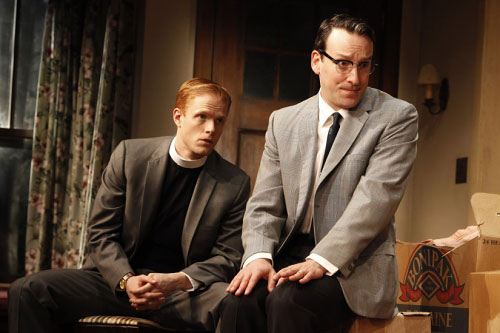
Jeremy Shamos: I don’t. I mean, we have had rehearsals pretty much every day, just like I said tweaking little things and lighting things and so, this is our first real week.
So, yeah, I mean, I usually get up — sometimes my wife lets me sleep in a little bit and she gets up with the kids and sometimes I get up with the kids and bring them to school — and then go home and take a little bit of a nap. But, in general, I don’t really have any interesting rituals. I try to kind of avoid rituals because, I guess, my fear would be that I would do something and then have a great show and then I would say, “Well I have to do that again every night.”
Like, you’d have to walk past 44th Street five times before you do the show.
Jeremy Shamos: Right, exactly. Or like, “Oh I know, like I had that dish at the Chinese restaurant and I had this amazing show.” So, after eating that dish, 300 times…. So, I think I try to avoid those kinds of things.
I know actors have crazy rituals, like I said, I have fallen into that trap before, and I have decided that I don’t know what causes a good show versus a mediocre show, and so, I just decided that I don’t have control over that, which is good.
Did you always want to be an actor?
Jeremy Shamos: I did. I always wanted to be an actor. I think I was in a school play when I was in the fourth or fifth grade, I was in the all school Christmas pageant, and I played the little boy. I think I was in the fourth grade. I just felt really comfortable on stage and I have always wanted to do it.
I have certainly gone through large chunks of time where I’ve doubted if it’s a smart thing to do, just given the kind of, the life of being an actor. But, I have always loved collaborating with people and I’ve always loved the theater as a place to go and to sort of see life reflected and I’ve always loved being a part of the process of putting on a play. So, I have always wanted to be around it and part of it and I’ve been lucky to have been able to do that. I also love going to movies and seeing great acting. I just admire it as an art form and as a craft and as a skill. So, it’s something that I’ve always wanted to do. Like I said, I’ve gone through chunks of time where I have wondered about the practical nature of doing it, and wondering if I’m good enough and if I sort of have what it takes to actually make a life of it. But I’ve never stopped loving it.
People have asked me, people who aren’t actors, like, “How do you do the same thing every night?” You know, when I’m in a longer running show. To me, it’s just so not the same thing every night and it’s so vastly different every night. Also, it’s so rewarding to perform for people who are appreciating something.
I said to a friend who’s a reporter actually, a really good reporter, but I said, “You know the feeling when you write a great piece or when your editor or somebody says, ‘Hey that was a great piece, I’m really glad you wrote that.’ Basically when you’re an actor on stage you kind of get that kind of positive feedback every night, so it makes work a nice place to go.” He says that his editor almost never says that to him.
Now you have him questioning himself.
Jeremy Shamos: [laughter] I think especially when everything comes together like in this play, where it’s smart and thought provoking and it leaves people unsettled and sort of walking away from the theater with something to discuss, you’re actually doing not only an artistic thing, but something that is potentially civic or something that leaves people different than when they came and so it feels good to be part of that.
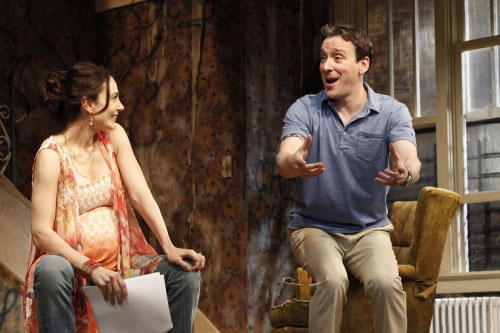
Jeremy Shamos: It’s constantly evolving depending on the project. I think one thing that I always tell younger actors, I think the most important thing to be able to be is flexible in terms of the way that you work.
I’m not saying that you shouldn’t have a process that works for you of how to access certain things within yourself, and how to analyze text and get the best out of a role — but at the end of the day, you have to be flexible and work the way that the company that you are a part of is working, because it’s really a truly, truly collaborative art form.
I feel like a lot of people sort of get settled in on a way that they work and then end up in a company where the director doesn’t relate to your vocabulary and doesn’t relate to the way that you are working on something and then all of a sudden there’s tension, or it’s not a pure collaboration. Whereas I feel like if you’re flexible with the way that you approach something and you are really open to hearing what a director and what other actors are bringing to the table then if you can be flexible in those moments, then you might surprise yourself and do something that you never thought you could do.
So, I think it is important to know how to use yourself in the way that you best can use yourself and access things within yourself. But, then I think it’s important to be really flexible about the way that you work on something.
I kind of liken it a little bit to playing basketball. If you are sort of like, “I always come into the game with a lot of energy, I always shoot 3s.” It’s like, at the end of the day you have to come into the game and see what the game is. Just having sort of a flexibility about the way that you play your game, and also what the coach is interested in you doing and also what the strength of the other players are and so you say, “There’s somebody who shoots 3s better than me and the coach wants me to do this and I’m flexible.” And like I said, you might learn something about yourself and say, “I never knew that I could do that, I always thought of myself as this kind of an actor. I always thought that my strength was in whatever emoting or being the center of attention.” Whereas, like in this production, I think, I’m really learning a lot about myself by fitting into this ensemble in this certain way by listening or by being this type of character.
So, I just think that, I’ve seen it so many times in plays that I’ve been in, that there are battles, personality battles. It’s because people are sort of rigid in the ways that they think about, the way that they have to do a play, or they have to approach a role in a certain way. I feel like when everyone is a little more open to a pure collaboration, people really surprise themselves and that’s when the best work gets done.
You kind of answered part of this question, but what is your advice to actors?
Jeremy Shamos: Yeah, I think that’s really my advice to actors. My advice to actors is to have as much experience and in life as you can, to work as much as you can with people who you respect and admire, to really make your best effort to listen to people and listen to what people are asking you to do, even if you disagree with it, because you’ll learn a lot about yourself.
For example, if you’re with a director who you, early on in the process, think, “I’m not sure this director knows what they’re talking about.” A lot of actors sort of tend to say, “Well, I don’t think that’s a good idea. The way you’re asking me doesn’t make sense and blah blah blah” and then there’s this sort of battle. As opposed to saying, “You know I’m going to do, today in this rehearsal, I’m going to just really, fully try to do what this director is asking me to do.” Both of you, the director and yourself, will learn something about the character and about that moment that you’re working on. Sometimes, a lot of times, the director will say, “You know what, you totally accomplished what I was asking you to do and I don’t’ think that it’s right. I’m glad that we did that. Now, let’s try something else.” At the very least you gained someone’s respect, because you have the skill to follow their idea.
I feel like the best advice I can give is to — I do feel like the word collaboration — I’m tossing it around a lot in this interview, but I feel like it’s the key to everything. It’s the key probably to marriage and friendship and all those things. But I really feel like in the theater and in acting it’s the ultimate thing and I think people sort of use the word and say like, “I love to collaborate with people.” But what that means to them is that they like doing their thing and then they like other people to tell them they’re doing a good job. But, at the end of the day, I think the real collaboration is the real give and take, and I feel like my advice to actors is always to ask yourself, “How can I accomplish what someone else is asking me to do? How can I change the way that I look at this to maybe accomplish this in a way that I never thought that I would.” Like I said, I think that those kinds of collaborations, you end up bringing out the best in each other. So, you end up a better actor for it. The piece that you’re in ends up better. Everyone looks better and everyone is better because they have been working together. I mean, it’s always two minds are better than one, and three minds, and so on.
Like in our play, when you get seven people doing a great play with a great director and with great designers and producers that are really involved and interested, you get a lot of minds working on something and not some sort of dictator or diva who is trying to drag everyone along their ride.

